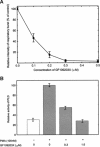Roles of phospholipase D in phorbol myristate acetate-stimulated neutrophil respiratory burst
- PMID: 20158570
- PMCID: PMC3922386
- DOI: 10.1111/j.1582-4934.2010.01035.x
Roles of phospholipase D in phorbol myristate acetate-stimulated neutrophil respiratory burst
Abstract
The phorbol myristate acetate (PMA) stimulated nutrophil respiratory burst has been considered to simply involve the activation of protein kinase C (PKC). However, the PLD activity was also increased by 10-fold in human neutrophils stimulated with 100 nM PMA. Unexpectedly, U73122, an inhibitor of phospholipase C, was found to significantly inhibit PMA-stimulated respiratory burst in human neutrophils. U73122 at the concentrations, which were sufficient to inhibit the respiratory burst completely, caused partial inhibition of the PLD activity but no inhibition on PKC translocation and activation, suggesting that PLD activity is also required in PMA-stimulated respiratory burst. Using 1-butanol, a PLD substrate, to block phosphatidic acid (PA) generation, the PMA-stimulated neutrophil respiratory burst was also partially inhibited, further indicating that PLD activation, possibly its hydrolytic product PA and diacylglycerol (DAG), is involved in PMA-stimulated respiratory burst. Since GF109203X, an inhibitor of PKC that could completely inhibit the respiratory burst in PMA-stimulated neutrophils, also caused certain suppression of PLD activation, it may suggest that PLD activation in PMA-stimulated neutrophils might be, to some extent, PKC dependent. To further study whether PLD contributes to the PMA stimulated respiratory burst through itself or its hydrolytic product, 1,2-dioctanoyl-sn-glycerol, an analogue of DAG , was used to prime cells at low concentration, and it reversed the inhibition of PMA-stimulated respiratory burst by U73122. The results indicate that U73122 may act as an inhibitor of PLD, and PLD activation is required in PMA-stimulated respiratory burst.
© 2011 The Authors Journal of Cellular and Molecular Medicine © 2011 Foundation for Cellular and Molecular Medicine/Blackwell Publishing Ltd.
Figures





References
-
- Babior BM. Oxygen-dependent microbial killing by phagocytes (first of two parts) N Engl J Med. 1978;298:659–68. - PubMed
-
- Thelen M, Dewald B, Baggiolini M. Neutrophil signal transduction and activation of the respiratory burst. Physiol Rev. 1993;73:797–821. - PubMed
-
- Nauseef WM, Volpp BD, McCormick S, et al. Assembly of the neutrophil respiratory burst oxidase. Protein kinase C promotes cytoskeletal and membrane association of cytosolic oxidase components. J Biol Chem. 1991;266:5911–7. - PubMed
-
- Exton JH. Phospholipase D: enzymology, mechanisms of regulation, and function. Physiol Rev. 1997;77:303–20. - PubMed
-
- Billah MM, Eckel S, Mullmann TJ, et al. Phosphatidylcholine hydrolysis by phospholipase D determines phosphatidate and diglyceride levels in chemotactic peptide-stimulated human neutrophils. Involvement of phosphatidate phosphohydrolase in signal transduction. J Biol Chem. 1989;264:17069–77. - PubMed
Publication types
MeSH terms
Substances
LinkOut - more resources
Full Text Sources

